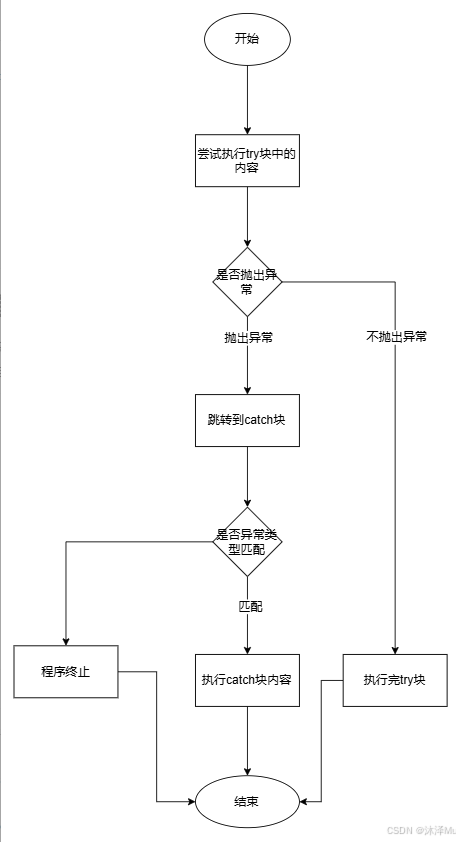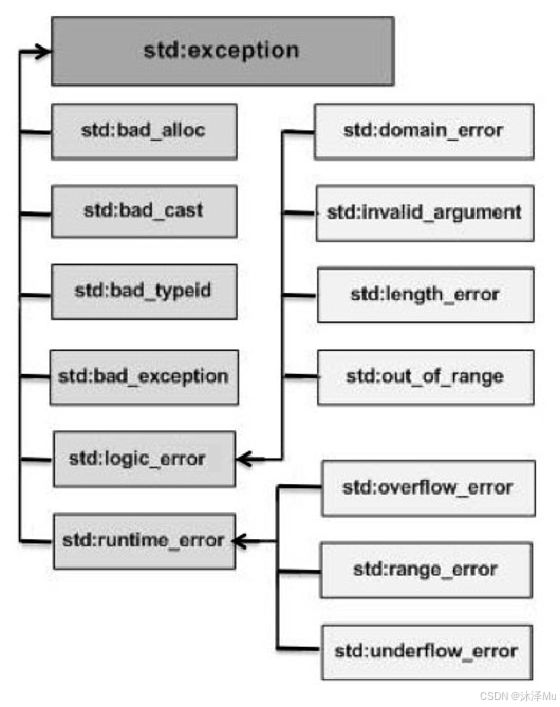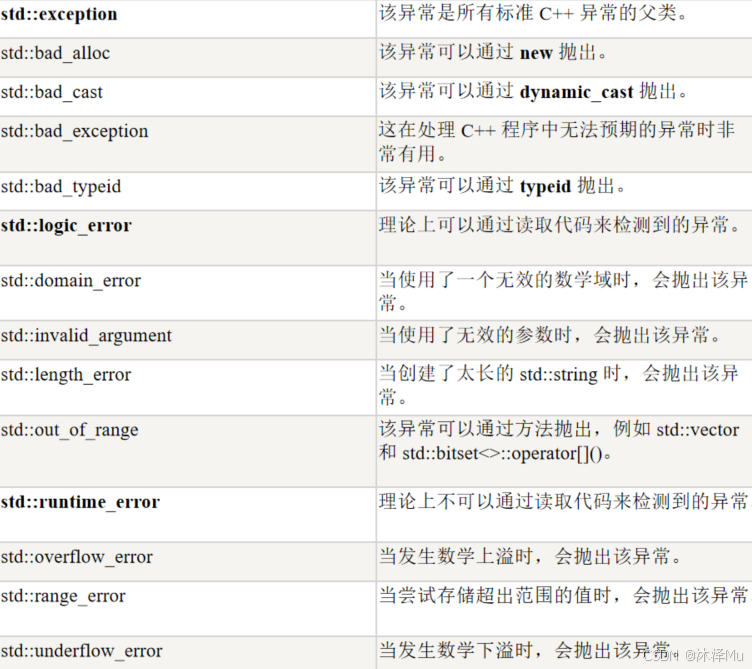1. 什么是异常?
异常是程序在运行期间产生的问题,即没有语法错误,出现的是逻辑错误,C++提供了一种转移程序控制权的方式:
- 异常经过程序员正确处理,继续运行;
- 异常没有经过程序员正确处理,运行终止。
例如之前使用string的at函数,范围越界的问题等。
处理异常的方式有两种:
- 抛出异常 throw
- 捕获异常 try-catch
2. 抛出异常
使用throw关键字可以抛出一个异常对象,throw可以抛出任何类型的异常对象,抛出到当前代码调用的上一级。
#include <iostream>
using namespace std;
double divide(double a,double b)
{
if(b == 0)
throw "除数不能为0!!!";
return a/b;
}
int main()
{
cout << divide(3,2) << endl; // 1.5
cout << divide(2,0) << endl; // 终止运行
cout << "程序运行结束" << endl;
return 0;
}
3. 捕获异常
捕获异常分为try代码块和catch代码块,try块中放置可能抛出异常的代码,catch块放置异常类型匹配的代码,处理逻辑如下:
情况1:抛出异常并捕获成功
#include <iostream>
using namespace std;
double divide(double a,double b)
{
if(b == 0)
throw "除数不能为0!!!";
return a/b;
}
int main()
{
try
{
cout << divide(2,0) << endl;
cout << "A" << endl;
}catch(const char* e)
{
cout << e << endl;
// 正常开发下,需要修复逻辑错误
}
cout << "程序运行结束" << endl;
return 0;
}情况2:抛出异常,捕获失败
#include <iostream>
using namespace std;
double divide(double a,double b)
{
if(b == 0)
throw "除数不能为0!!!";
return a/b;
}
int main()
{
try
{
cout << divide(2,0) << endl;
cout << "A" << endl;
}catch(int e)
{
cout << e << endl;
// 正常开发下,需要修复逻辑错误
}
cout << "程序运行结束" << endl;
return 0;
}情况3:没有抛出异常,正常直接try块结束。
#include <iostream>
using namespace std;
double divide(double a,double b)
{
if(b == 0)
throw "除数不能为0!!!";
return a/b;
}
int main()
{
try
{
cout << divide(2,1) << endl;
cout << "A" << endl;
}catch(int e)
{
cout << e << endl;
// 正常开发下,需要修复逻辑错误
}
cout << "程序运行结束" << endl;
return 0;
}异常如果不在当前层次进行处理,也可以交给上一级进行处理,但是如果主函数中还没有正确处理,则程序终止。
#include <iostream>
using namespace std;
double divide(double a,double b)
{
if(b == 0)
throw "除数不能为0!!!";
return a/b;
}
void test()
{
try
{
cout << divide(2,0) << endl;
cout << "A" << endl;
}catch(int e)
{
cout << "B" << endl;
cout << e << endl;
// 正常开发下,需要修复逻辑错误
}
}
int main()
{
try
{
test();
}catch(const char* e)
{
cout << "C" << endl;
cout << e << endl;
// 正常开发下,需要修复逻辑错误
}
cout << "程序运行结束" << endl;
return 0;
}4. 标准异常族
C++为常见的异常类型进行层次划分,通过继承实现。
使用标准异常族需要引入头文件 #include <stdexcept>
自定义异常类型应该通过继承加入上面的结构。
#include <iostream>
#include <stdexcept> // 头文件
using namespace std;
class ZeroException:public exception
{
public:
// throw() 是异常规格说明,表示what函数不会抛出任何异常
const char* what() const throw()
{
return "除数不能为0!!!";
}
};
double divide(double a,double b)
{
if(b == 0)
throw ZeroException();
return a/b;
}
int main()
{
try
{
cout << divide(2,0) << endl;
cout << "A" << endl;
}catch(const ZeroException& e)
{
cout << e.what() << endl;
// 正常开发下,需要修复逻辑错误
}
cout << "程序运行结束" << endl;
return 0;
}5. 异常捕获技巧
5.1 捕获基类异常
所有抛出的派生类异常对象都可以被其基类异常类型捕获。
#include <iostream>
#include <stdexcept> // 头文件
using namespace std;
void poly_except()
{
int a = 1;
if(a == 1)
{
throw out_of_range("hah");
}else {
throw domain_error("随便");
}
}
int main()
{
try
{
poly_except();
}catch(const logic_error& e)
{
cout << e.what() << endl;
// TODO 修复逻辑代码
}
cout << "程序运行结束" << endl;
return 0;
}5.2 多重捕获
可以使用多个catch块配合try块进行异常捕获,catch的顺序要求派生类异常先捕获,基类异常后捕获。
#include <iostream>
#include <stdexcept> // 头文件
using namespace std;
void poly_except()
{
int a = 2;
if(a == 1)
{
string s;
s.at(-1);
}else {
throw underflow_error("f");
}
}
int main()
{
try
{
poly_except();
}catch(const out_of_range& e)
{
cout << "A" << endl;
}catch(const domain_error& e)
{
cout << "B" << endl;
}catch(const logic_error& e)
{
cout << "C" << endl;
}catch(const exception& e)
{
cout << "D" << endl;
}
cout << "程序运行结束" << endl;
return 0;
}还可以单独使用一个...捕获所有异常,但是不推荐。
#include <iostream>
#include <stdexcept> // 头文件
using namespace std;
void poly_except()
{
int a = 2;
if(a == 1)
{
string s;
s.at(-1);
}else {
throw "fdfdfd";
}
}
int main()
{
try
{
poly_except();
}catch(...)
{
cout << "A" << endl;
}
cout << "程序运行结束" << endl;
return 0;
}C++的异常处理机制并不完善,是否使用取决于开发团队的要求。


